April 21, 2024
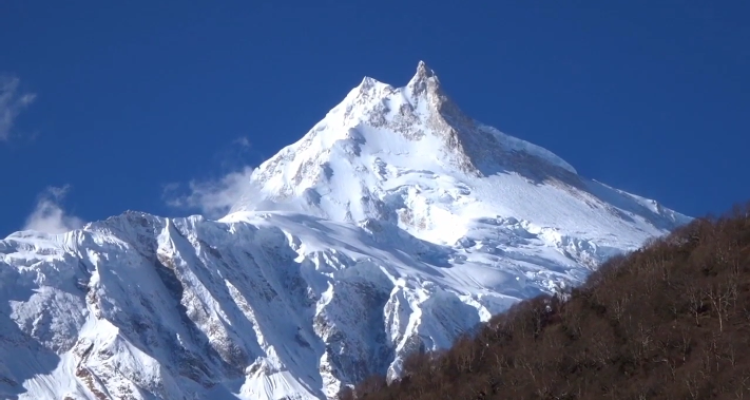
Nepal, a landlocked Himalayan nation nestled between China and India, is a paradise for trekkers seeking awe-inspiring landscapes, rich culture, and adventure. Among its many treasures, three iconic treks stand out: Everest Base Camp, Annapurna Base Camp, and Manaslu Circuit.
Everest Base Camp Trek- 12 days is a legendary journey that captivates adventurers worldwide. It offers a chance to walk in the footsteps of mountaineering legends, leading to the base of the world’s tallest peak, Mount Everest (8,848 meters). The trail winds through the Sagarmatha National Park, showcasing breathtaking vistas of towepeaks peak, lush forests, and Sherpa villages adorned with prayer flags. Trekkers immerse themselves in Sherpa culture, passing through vibrant Namche Bazaar and Tengboche Monastery, all while acclimatizing to the high altitude.
Annapurna Base Camp Trek presents a diverse tapestry of landscapes, from terraced fields to lush rhododendron forests and alpine meadows. Nestled at the foot of the majestic Annapurna massif, this trek offers spellbinding views of Annapurna I (8,091 meters) and Machapuchare (6,993 meters). Along the trail, trekkers encounter ethnic Gurung and Magar villages, each with its own unique charm and hospitality. The trek culminates at Annapurna Base Camp, surrounded by towering peaks, creating an unforgettable sense of accomplishment.
Manaslu Circuit Trek, a lesser-known but equally rewarding, traverses the remote and untouched regions of the Manaslu Conservation Area. This trek offers a glimpse into traditional Tibetan culture, as the trail skirts the eighth-highest peak in the world, Mount Manaslu (8,163 meters). Trekkers are treated to panoramic views of snow-capped peaks, pristine rivers, and cascading waterfalls, all while encountering authentic villages adorned with colorful prayer flags. The highlight of the trek is crossing the challenging Larkya La Pass (5,160 meters), offering unparalleled vistas of the Himalayan range.
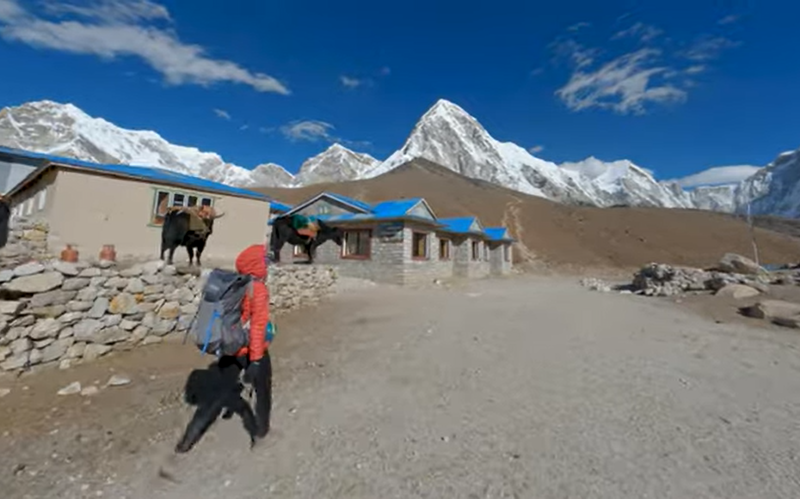
Beautiful Gorakshep -the last settlements of EBC Trek
Trekking to Everest Base Camp presents several challenges that adventurers must be prepared to face. The most significant challenge is the high altitude, with the trek reaching elevations of over 5,000 meters. Altitude sickness, characterized by symptoms like headache, nausea, and fatigue, is a real concern and requires acclimatization days and a slow ascent to mitigate its effects. Additionally, the rugged terrain, variable weather conditions, and long trekking days demand physical fitness and mental resilience from trekkers.
Physical Preparation: Before heading to Everest Base Camp, ensure you’re physically fit by doing some cardio and endurance training.
Altitude Acclimatization: Allow your body time to adjust to the altitude gradually by planning your itinerary with enough rest days.
Packing Essentials: Pack light but don’t forget warm clothing, sturdy trekking boots, sunscreen, and personal medications.
Hydration and Nutrition: Stay hydrated by drinking plenty of water and ensure you’re consuming enough calories to fuel your body for the trek.
Weather Awareness: Be prepared for unpredictable weather conditions with warm gear and by checking the forecast beforehand.
Permits and Documentation: Obtain the necessary permits like the Sagarmatha National Park Entry Permit and TIMS Card.
Local Culture and Etiquette: Respect local customs, learn a few basic phrases, and always ask before taking photos.
Travel Insurance: Get comprehensive travel insurance covering high-altitude trekking and emergency medical evacuation.
Guided vs. Independent Trekking: Decide whether you want to trek independently or with a guide and porter.
Leave No Trace: Practice Leave No Trace principles to minimize environmental impact.
Emergency Contacts: Carry a list of emergency contacts including your embassy and local emergency services or Related Travel company in Nepal.
Choosing the right time to embark on the Everest Base Camp trek is crucial for a safe and enjoyable experience. The optimal trekking seasons are the pre-monsoon (spring) months from March to May and the post-monsoon (autumn) months from September to November. During these periods, the weather is relatively stable, with clear skies and mild temperatures, providing excellent visibility of the surrounding peaks and minimizing the risk of monsoon rains or harsh winter conditions.
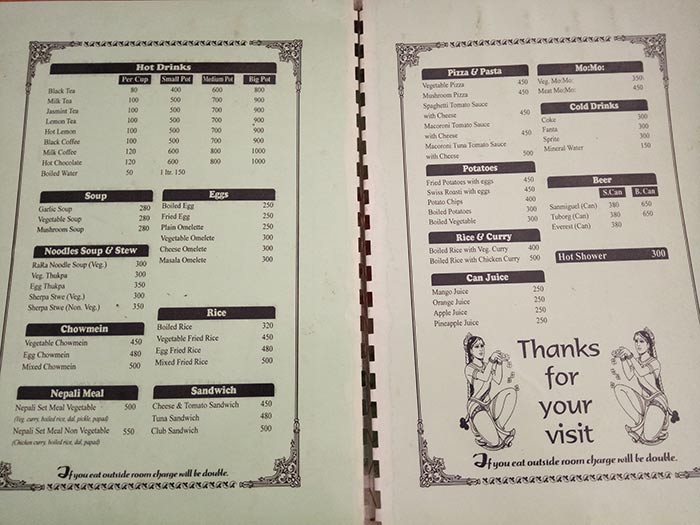
Foood Menu of Everest base camp trek
Throughout the Everest Base Camp trek, trekkers are accommodated in teahouses, which are basic but comfortable lodges catering to travelers along the route. These teahouses offer a range of amenities, including simple rooms with beds and blankets, communal dining areas, and shared bathroom facilities. Meals served in teahouses typically consist of hearty Nepali fare, such as dal bhat (rice and lentils), noodles, soups, and vegetable curries, supplemented by Western dishes like pancakes and pasta. Trekkers can expect warm hospitality from teahouse hosts and the opportunity to refuel with nutritious meals after a day of trekking.
The cost of trekking to Everest Base Camp can vary depending on a few factors. If you’re going solo, it might be around $1399 or more. But if you’re in a group of at least two to five people, it could be about $1225 per person. However, the final cost depends on things like the size of your group, the type of hotels you stay in while in Kathmandu, whether the package includes a tour of the city, and how many guides and porters you have. So, the prices I mentioned are just estimates.
Day 1: Arrival in Kathmandu (1,400 meters)
Day 2: Kathmandu sightseeing and trek preparation
Day 3: Fly to Lukla, trek to Phakding (2,610 meters)
Day 4: Phakding to Namche Bazaar (3,440 meters)
Day 5: Acclimatization day in Namche Bazaar
Day 6: Namche Bazaar to Tengboche (3,860 meters)
Day 7: Tengboche to Dingboche (4,410 meters)
Day 8: Acclimatization day in Dingboche
Day 9: Dingboche to Lobuche (4,940 meters)
Day 10: Lobuche to Gorak Shep (5,170 meters), visit Everest Base Camp (5,364 meters), return to Gorak Shep
Day 11: Gorak Shep to Kala Patthar (5,545 meters), then descend to Pheriche (4,240 meters)
Day 12: Pheriche to Namche Bazaar
Day 13: Namche Bazaar to Lukla
Day 14: Fly back to Kathmandu
Day 15: Departure from Kathmandu
For trekkers seeking a well-organized and hassle-free Everest Base Camp trekking experience, join a group tour with a reputable local agency like Safe Holiday Adventure Pvt. Ltd is an excellent option. With years of experience leading treks in the region, Safe Holiday Adventure Pvt. Ltd provides expert guides, porter services, and comprehensive itineraries tailored to the needs and preferences of their clients. By joining a group trek, trekkers can enjoy the camaraderie of like-minded adventurers, share the journey with fellow travelers, and benefit from the logistical support and safety measures provided by the agency. Safe Holiday Adventure Pvt. Ltd ensures that every aspect of the trek, from transportation to accommodation to dining, is meticulously planned and executed, allowing trekkers to focus on immersing themselves in the awe-inspiring landscapes and cultural encounters of the Everest region.
The Manaslu Circuit Trek is a captivating journey through the rugged terrain of the Nepalese Himalayas, offering trekkers an immersive experience in both natural beauty and cultural richness. As adventurers embark on this trail, they are greeted by a panorama of majestic peaks, with the imposing Mount Manaslu reigning supreme among them. The trek begins in the quaint village of Soti Khola, where travelers set foot on a path that winds its way through verdant forests, tracing the course of the roaring Budhi Gandaki River.
As trekkers ascend higher into the mountains, the landscape transforms, revealing alpine meadows adorned with vibrant wildflowers and towering cliffs that seem to touch the sky. Along the way, the trail passes through traditional Nepalese villages nestled amidst terraced fields, where locals tend to their crops and livestock, preserving age-old ways of life. The warmth and hospitality of the villagers offer a glimpse into the rich cultural tapestry of the region, where ethnic groups such as the Gurungs, Sherpas, and Tibetans coexist harmoniously.
However, the Manaslu Circuit Trek is not without its challenges. The rugged terrain and steep ascents demand physical endurance and mental fortitude from trekkers. As the altitude increases, so does the thinness of the air, posing a challenge to even the most seasoned adventurers. Acclimatization stops become essential to allow the body to adjust to the altitude and mitigate the risk of altitude sickness.
Yet, it is precisely these challenges that make the Manaslu Circuit Trek a truly transformative experience. Each step taken is not only a physical journey but also a spiritual one, as trekkers find themselves humbled by the awe-inspiring grandeur of the Himalayas and enriched by the cultural encounters along the way. Whether gazing upon the snow-capped peaks from the Larkya La Pass or sharing stories with locals around a crackling fire, every moment on the Manaslu Circuit Trek is imbued with a sense of adventure and discovery, leaving an indelible mark on the hearts and minds of those who undertake this extraordinary journey.
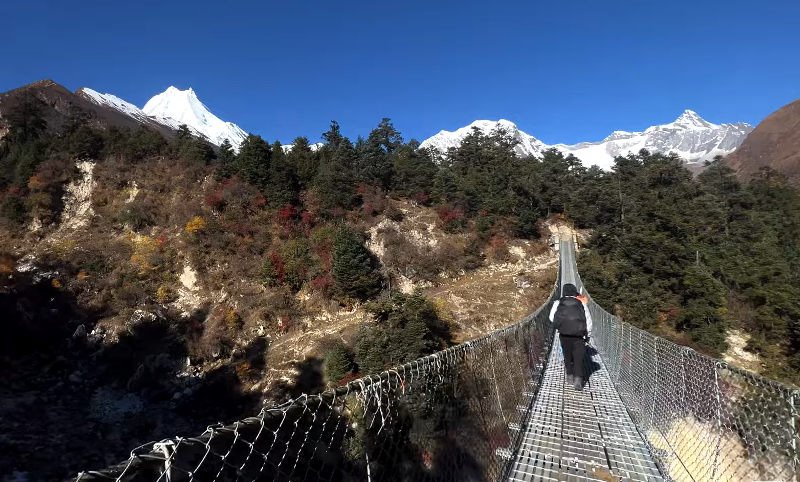
Suspension bridge in Manaslu trekking
Day 1: Arrival in Kathmandu (1,400 meters)
Day 2: Kathmandu sightseeing and trek preparation
Day 3: Drive from Kathmandu to Soti Khola (700 meters)
Day 4: Soti Khola to Machha Khola (900 meters)
Day 5: Machha Khola to Jagat (1,410 meters)
Day 6: Jagat to Deng (1,800 meters)
Day 7: Deng to Namrung (2,630 meters)
Day 8: Namrung to Samagaon (3,530 meters)
Day 9: Acclimatization Day in Samagaon
Day 10: Samagaon to Samdo (3,860 meters)
Day 11: Side trip to Tibet border or acclimatization day in Samdo
Day 12: Samdo to Dharamsala/Larkya Phedi (4,460 meters)
Day 13: Dharamsala to Larkya La Pass (5,160 meters), then descend to Bimthang (3,720 meters)
Day 14: Bimthang to Tilije (2,300 meters)
Day 15: Tilije to Tal (1,700 meters)
Day 16: Tal to Syange (1,100 meters)
Day 17: Syange to Besisahar, then drive back to Kathmandu
Day 18: Departure from Kathmandu
The Manaslu Circuit Trek is considered to be moderately challenging, and suitable for trekkers with some previous hiking experience and a good level of fitness. The trek involves high-altitude walking, with the highest point reaching over 5,000 meters (16,500 feet) at the Larkya La Pass.
The terrain varies from lush green landscapes to rugged mountain paths, and you’ll encounter steep ascents and descents along the way. Altitude sickness can also be a concern, so it’s important to acclimatize properly and listen to your body.
Overall, while the Manaslu trek offers stunning scenery and a sense of remoteness, it does require physical preparation and mental determination. Hiring a knowledgeable guide and porter can enhance your experience and ensure your safety on the trail.
For a 13-day trek to Manaslu with two people, expect to spend around $1,480 to $2,350 per person. This includes permits, guide/porter fees, transportation to Soti Khola (the starting point), accommodation and meals in tea houses along the trek, and miscellaneous expenses. Permits typically cost $70-$100 per person, while guide/porter fees range from $20 to $30 per day. Transportation by private jeep or bus can amount to $100-$150 each way. Accommodation and meals in tea houses add up to about $20 to $30 per person per day, and miscellaneous expenses such as snacks and tips amount to $100 to $150 for the trip.
For groups of five or more, costs can decrease by around 10-20% per person due to shared expenses. Permits would be around $28 to $40 per person, guide/porter fees would be about $400 to $600 for the entire group, transportation costs would decrease to $40 to $60 per person, and accommodation and meals would average $416 to $624 per person. Miscellaneous expenses would be around $80 to $120 per person. Overall, the total cost per person for a larger group would range from $964 to $1,444 for the 13-day trek. These estimates may vary based on factors like season, specific services, and negotiation with local trekking agencies.
The best time to go on the Manaslu trek is during the spring (March to May) and autumn (September to November) seasons.
During the spring, the weather is generally clear with mild temperatures, making it ideal for trekking. The rhododendrons and other wildflowers are in bloom, adding vibrant colors to the landscape.
In the autumn months, after the monsoon season has ended, the skies clear up, offering excellent visibility of the surrounding mountains. The temperatures are also comfortable, and the trails are usually dry and stable, making for easier hiking conditions.
Both seasons offer stunning views of the Himalayas and are less likely to be affected by heavy rainfall or snowfall, which can make trekking more challenging during the monsoon (June to August) and winter (December to February) months. However, it’s always a good idea to check weather forecasts and trail conditions before embarking on any trek.
Certainly! Here are some tips for trekkers planning to embark on the Manaslu Circuit Trek:
Acclimatize Properly: Altitude sickness can be a real concern on high-altitude treks like Manaslu. Take your time to acclimatize at various points along the trail to minimize the risk.
Train Beforehand: Strengthen your legs and improve your cardiovascular fitness before the trek. Regular cardio workouts, hiking, and stair climbing can help prepare your body for the physical demands of the trail.
Pack Light: Only bring essential items to keep your backpack weight manageable. Remember, you’ll be carrying everything yourself, so prioritize lightweight and multi-purpose gear.
Stay Hydrated and Eat Well: Drink plenty of water throughout the trek to stay hydrated, and eat a balanced diet to maintain your energy levels. Carry water purification tablets or a filtration system to refill your bottle from natural water sources safely.
Dress in Layers: The weather in the Himalayas can be unpredictable, with temperatures varying greatly throughout the day. Dress in layers so you can easily adjust to changing conditions.
Respect Local Culture: Be mindful of the local customs, traditions, and beliefs of the communities you encounter along the trail. Dress modestly, ask for permission before taking photos, and always greet locals with respect.
Pack a First Aid Kit: Carry a basic first aid kit with essentials like bandages, antiseptic wipes, blister pads, pain relievers, and any personal medications you may need. Know how to use the items in your kit.
Be Prepared for Basic Accommodations: While teahouses along the Manaslu Circuit Trek provide shelter and meals, they offer basic amenities. Expect shared rooms and simple facilities. Bring earplugs and a sleeping mask for better rest.
Follow Leave No Trace Principles: Minimize your impact on the environment by packing out all trash, using designated toilet facilities, and avoiding single-use plastics. Leave the trail as beautiful as you found it for future trekkers to enjoy.
Stay Flexible: Weather conditions, trail closures, and personal health can all affect your trekking plans. Stay flexible and be prepared to adjust your itinerary as needed for safety and enjoyment.
By following these tips and adequately preparing for your Manaslu Circuit Trek, you’ll enhance your overall experience and make the most of this incredible adventure in the Himalayas.
Trekking through the stunning landscapes of the Manaslu region in Nepal offers not only breathtaking views of the Himalayas but also a rich cultural experience. Along the Manaslu Circuit, trekkers are welcomed by a network of teahouses and lodges that dot the route, providing essential food and accommodation. These teahouses serve as vital rest stops for weary travelers, offering hearty meals and a warm place to rest after a day of trekking.
In terms of food, trekkers can expect a diverse menu showcasing traditional Nepali dishes alongside familiar favorites. Dal Bhat, a staple Nepali meal consisting of rice, lentils, and vegetables, is a popular choice among trekkers for its nutritious and filling qualities. Additionally, steaming bowls of noodle soup and plates of momos, savory dumplings filled with meat or vegetables, provide comforting sustenance amidst the mountainous terrain. While the availability of food remains consistent in lower-altitude villages, trekkers ascending to higher elevations may encounter a more limited selection due to logistical challenges.
Accommodation along the Manaslu Circuit primarily consists of teahouses and lodges, which offer basic yet cozy lodging options for trekkers. These accommodations typically feature communal dining areas where trekkers can gather to share stories and meals, fostering a sense of camaraderie among fellow adventurers. As trekkers ascend to higher altitudes, the quality of accommodation may vary, with shared amenities such as bathrooms and sleeping quarters becoming more common. Despite the rustic nature of these lodgings, trekkers can expect warm hospitality from local hosts who take pride in sharing their culture with visitors.
While teahouses and lodges are the preferred accommodation choice for most trekkers, camping is also an option for those seeking a more immersive wilderness experience. However, camping requires careful planning and self-sufficiency in terms of food and equipment, as amenities may be scarce in remote areas. Regardless of the chosen accommodation style, trekkers are encouraged to embrace the unique cultural experiences and breathtaking natural beauty that the Manaslu region has to offer, making memories that will last a lifetime.
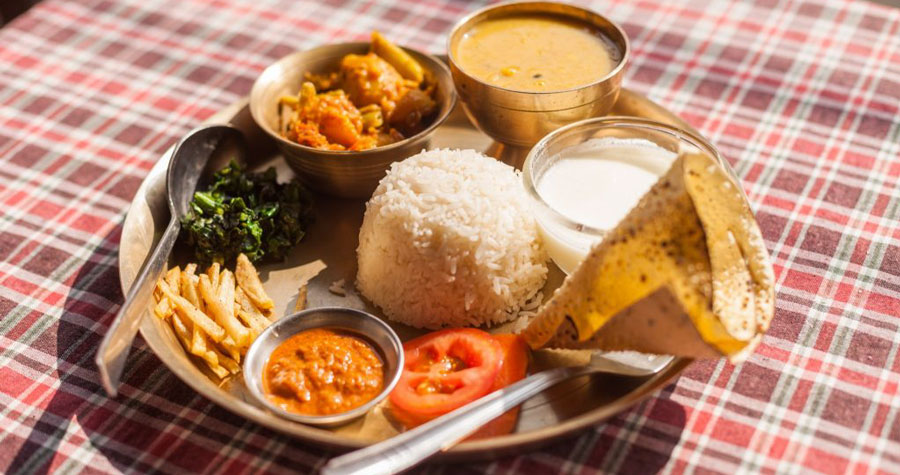
The Annapurna Base Camp Trek is a renowned trekking route in Nepal, attracting adventurers from around the world to experience the awe-inspiring beauty of the Himalayas. This trek typically begins in the vibrant town of Pokhara, a popular hub for trekkers, where preparations are made before embarking on the journey. From Pokhara, trekkers travel by bus or car to the starting point of the trek, usually Nayapul or Phedi, depending on the chosen route.
As the trek unfolds, trekkers traverse a diverse landscape that includes charming villages, terraced fields, dense forests, and rushing rivers. Along the way, rustic tea houses and lodges provide accommodation and meals, offering trekkers a chance to rest and refuel amidst the natural splendor. The trails are well-marked, ensuring that trekkers can navigate the terrain safely and enjoyably.
One of the highlights of the Annapurna Base Camp Trek is the opportunity to witness breathtaking views of the Annapurna mountain range, including the iconic peaks of Annapurna I, Machapuchare, and Hiunchuli. These majestic snow-capped mountains tower above serene valleys, creating a dramatic backdrop for the trekking experience. Trekkers also encounter a rich diversity of flora and fauna, adding to the enchantment of the journey.
As trekkers ascend higher into the mountains, they must acclimatize to the altitude to prevent altitude sickness. Rest days are incorporated into the itinerary to allow trekkers to adjust to the reduced oxygen levels gradually. This precaution is essential for ensuring the health and safety of trekkers as they make their way to higher elevations.
The ultimate destination of the Annapurna Base Camp Trek is Annapurna Base Camp itself, situated at an altitude of approximately 4,130 meters (13,550 feet). Here, trekkers are rewarded with a panoramic vista of towering peaks encircling a natural amphitheater. The sense of accomplishment and wonder upon reaching the base camp is unparalleled, making the journey truly memorable.
After spending time at Annapurna Base Camp, trekkers begin their descent back to lower altitudes, retracing their steps along familiar trails. The return journey offers a chance to reflect on the experiences and achievements of the trek, as well as to savor the final moments amidst the Himalayan landscape.
In conclusion, the Annapurna Base Camp Trek(ABCtrek) is a professionally guided adventure that offers trekkers an unforgettable exploration of Nepal’s mountainous terrain. With its stunning vistas, diverse ecosystems, and cultural encounters along the way, this trek is a testament to the enduring allure of the Himalayas.
The best time to embark on the Annapurna Base Camp (ABC) Trek in Nepal is generally during the spring and autumn seasons, which span from March to May and from September to November respectively. These months offer the most favorable weather conditions for trekking, with clear skies, mild temperatures, and minimal precipitation.
During the spring months of March to May, the landscape comes alive with vibrant rhododendron blooms and lush greenery, creating a picturesque backdrop for the trek. The weather is typically warm during the day and cool at night, making it ideal for comfortable trekking conditions. Additionally, the visibility is excellent, allowing trekkers to enjoy unobstructed views of the majestic Himalayan peaks.
Similarly, the autumn months of September to November are characterized by stable weather patterns, with clear skies and mild temperatures. This season is considered the peak trekking season in Nepal, attracting a large number of trekkers to the Annapurna region. The crisp mountain air, stunning vistas, and favorable trekking conditions make it an ideal time to undertake the ABC Trek.
While these months are generally regarded as the best time for the ABC Trek, it’s essential to be mindful of potential fluctuations in weather conditions and to check local forecasts before embarking on the journey. Ultimately, the choice of when to undertake the trek depends on personal preferences and priorities, but spring and autumn offer the optimal balance of weather, scenery, and trekking conditions for an unforgettable adventure in the Annapurna region.
The difficulty of the Annapurna Base Camp (ABC) Trek can vary depending on factors such as individual fitness levels, altitude acclimatization, and weather conditions. Overall, the ABC Trek is considered to be moderately challenging, making it accessible to trekkers with a reasonable level of fitness and some prior trekking experience.
The trek involves walking for several hours each day, often on uneven terrain and ascending and descending steep sections of the trail. Trekkers may also encounter high altitudes as they ascend to Annapurna Base Camp, which can present challenges such as altitude sickness. However, the trek is generally well-marked, and there are plenty of opportunities to rest and acclimatize along the way.
With proper preparation, including physical training, adequate acclimatization, and careful planning, many trekkers find the ABC Trek to be a rewarding and manageable adventure. Hiring a local guide or joining a guided trekking group can also enhance the experience by providing support, navigation assistance, and valuable insights into the local culture and environment.
While the ABC Trek requires effort and determination, the stunning scenery, cultural encounters, and sense of accomplishment upon reaching Annapurna Base Camp make it a truly unforgettable journey for those who undertake it.
Day 1: Kathmandu (1,400m)
Day 2: Drive to Pokhara (820m)
Day 3: Drive to Nayapul, Trek to Tikhedhunga (1,540m)
Day 4: Trek to Ghorepani (2,860m)
Day 5: Early morning hike to Poon Hill (3,210m), then trek to Tadapani (2,610m)
Day 6: Trek to Chhomrong (2,170m)
Day 7: Trek to Bamboo (2,310m)
Day 8: Trek to Deurali (3,230m)
Day 9: Trek to Annapurna Base Camp (4,130m)
Day 10: Trek back to Bamboo (2,310m)
Day 11: Trek to Jhinu Danda (1,780m)
Day 12: Trek to Nayapul, drive to Pokhara
Day 13: Drive back to Kathmandu
Are you ready for an unforgettable journey amidst the majestic Himalayas? At Safe Holiday Adventure, we’re thrilled to invite you to join our upcoming trek to the breathtaking Annapurna Base Camp (ABC)! Get ready to immerse yourself in the stunning beauty of the Nepalese mountains, experience local culture, and create memories that will last a lifetime.
For a classic Annapurna Base Camp trek, starting from Poon Hill via Ghorepani, the all-inclusive cost for two trekkers typically amounts to around $790. For a group of five or more individuals, the cost per person can decrease significantly to approximately $675. These costs cover permits, guide/porter fees, transportation, accommodation, meals, and miscellaneous expenses. It’s recommended to hire a guide, with daily fees ranging from $20 to $30, and transportation from Kathmandu to Nayapul costing approximately $100 to $150 each way. Accommodation and meals in tea houses along the route generally amount to $20 to $30 per person per day, with additional expenses for snacks, beverages, hot showers, and tips.
Option 1: Nayapul – Ghorepani – Chhomrong – ABC – Landruk – Phedi – Pokhara
This classic route provides a comprehensive trekking experience through diverse landscapes and cultural highlights. Starting from Nayapul, trekkers embark on a journey through lush forests and charming villages towards Ghorepani, where they witness stunning sunrise views over the Himalayas from Poon Hill. Continuing onwards, the trail leads through rhododendron forests to the picturesque village of Tadapani before descending to Chhomrong. From Chhomrong, the path ascends into the Annapurna Sanctuary, culminating at the iconic Annapurna Base Camp, surrounded by towering peaks. After enjoying the breathtaking scenery, trekkers descend to Landruk and then Phedi, where a drive back to Pokhara concludes the adventure.
Option 2: Shortcut Route: Drive from Pokhara to Jhinu – Deurali – ABC – Return via the Same Route to Jhinu – Drive to Pokhara
This expedited route offers a more time-efficient trekking experience for those with limited time. Beginning with a scenic drive from Pokhara to Jhinu, trekkers bypass the initial sections of the trail. From Jhinu, the trek ascends directly to Deurali, passing through lush forests and cascading waterfalls. Continuing upwards, the trail leads to Annapurna Base Camp, where panoramic views of the surrounding peaks await. After reveling in the breathtaking scenery, trekkers retrace their steps back to Jhinu before returning to Pokhara via the same route.
Option 3: Pokhara – Kande – Landruk – Jhinu – Sinuwa – Deurali – ABC – Chhomrung – Jhinu – Drive to Pokhara
This route combines the convenience of transportation with the beauty of trekking, offering a varied and rewarding journey. Beginning in Pokhara, trekkers are driven to Kande, where the trek commences towards Landruk, passing through terraced fields and traditional Gurung villages. From Landruk, the trail descends to Jhinu, where trekkers can relax in natural hot springs. Continuing onwards, the path leads through Sinuwa and Deurali before reaching Annapurna Base Camp, surrounded by towering peaks. After soaking in the breathtaking scenery, trekkers descend to Chhomrung before returning to Jhinu and concluding the trek with a drive back to Pokhara.
Each of these route options offers a unique perspective of the Annapurna region, allowing trekkers to tailor their experience based on their preferences and time constraints.
Nepal offers a wide array of trekking routes, varying in length from short to long and everything in between. However, three particular routes stand out as the most popular among trekkers. If you find yourself short on time or constrained by a tight budget but still harbor the dream of trekking in Nepal, we recommend opting for shorter, more budget-friendly routes. Examples include the Mardi Himal trek, Poon Hill trek, and Langtang trek, each lasting around six days. Additionally, there are other options such as the Khopra trek, Everest view trek, and Nagarkot hiking, each offering unique experiences and lasting around three days, starting from Kathmandu.
Check out this related article about trekking and touring in Nepal! If you’re interested in learning more, simply click the link below to get all the information you need and be well-informed.
Welcome to Nepal, and thank you for being here!